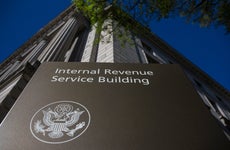How to prep your investment tax documents for tax day

The Bankrate promise
At Bankrate we strive to help you make smarter financial decisions. While we adhere to strict , this post may contain references to products from our partners. Here's an explanation for .
If you have investments, you’ll need to prepare a special set of documents in order to properly file your tax return. These investment tax documents show key elements of your income, including interest, dividends and capital gains, among other things. While it may be easy to forget investment income, if you’re not reporting all your earnings, the IRS will come after you.
Here’s how to prep your investment tax documents and the key things about your tax forms.
What investment tax documents do you need?
If you have a brokerage account, you’ll likely need to have at least three documents, though it does depend on the specific type of investments you have. Most investors will need to look for these key documents:
- 1099-INT
- This document reports interest you’ve earned at the specific institution.
- 1099-DIV
- This document reports dividends you’ve received at a brokerage.
- 1099-B
- This document reports capital gains and losses at a brokerage or crypto exchange, which are vital for figuring your capital gains taxes or getting a tax break.
Both banks and brokerages will send you 1099-INT forms at the start of the year. You’ll receive a 1099-DIV and 1099-B form from brokerages, typically by February 15 of each year. At brokerages these forms are often all in the same document called a consolidated 1099, with a specific section for each of the statements above. Those working with a cryptocurrency exchange should receive relevant 1099 forms for any income and capital gains and losses, too.
But some investors may receive other kinds of statements that they’ll need to file, including:
- 1099-R
- This document reports income from retirement accounts such as a 401(k), IRA, pension or an annuity. You’ll get one if you roll over a retirement plan, too.
- 1099-MISC
- This document includes miscellaneous income from a brokerage or other institution, such as “payments in lieu of dividends or interest,” which needed to be filed.
- Margin interest
- If you borrowed money from your brokerage on a margin account, then your broker’s consolidated 1099 will report how much interest you paid, and you can write off this investment expense if you itemize your deductions on your return.
- Schedule K-1
- You’ll receive this form if you’ve invested in a partnership, whether it’s private or publicly traded. It reports your income and investments in the partnership.
Other more sophisticated investors may receive yet other kinds of statements reporting income.
Who provides tax forms for investors?
Your financial institution will provide the relevant forms for your account and must do so in a timely manner. These forms arrive starting at the end of January and then roll into February.
- Banks, brokers, crypto exchanges, insurance companies and other financial institutions will provide the relevant 1099 forms to clients.
- Brokers typically report miscellaneous income and margin interest as part of a consolidated 1099 that includes a variety of income.
- A partnership, including a publicly traded partnership, will send a K-1 statement directly to individuals.
If you’re trading cryptocurrency and you don’t receive a statement from your institution, you don’t get out of paying tax on capital gains. You’ll need to add up your gains and losses, and then report the income yourself. Don’t assume that you can skip taxes due to a missing 1099.
Where can tax documents trip you up when filing?
Given the wide range of forms out there, it’s vital to check all your accounts to see whether you have received a tax statement from them. It can be easy to overlook a form when you’re in a rush or you simply forgot about an account. Here are other key watch points:
- Don’t file too early or you’ll miss forms: If you file too early, you may miss key tax forms. While banks and other form providers may be required to deliver forms by January 31, brokers and some others have until February 15 typically. Even then, you may need to have the broker correct a form or otherwise refile your taxes later.
- Consolidated statements have many pieces of data: A consolidated 1099 from your broker may have many pieces of data – a 1099-INT, a 1099-DIV, a 1099-B and more – so be sure that you’ve found all the reported data and entered it on your tax filing.
- A 1099-INT may appear on your brokerage statement: It can be easy to overlook, but your broker typically has a 1099-INT for interest payments, so record that income.
- A 1099-DIV includes many types of payments: Investment income can come in many different forms and it’s all reported on a 1099-DIV. Report it accurately.
- Qualified dividends and real estate income receive preferential treatment: Some types of investment income receive special treatment such as lower tax rates. Make sure you’re not overpaying by correctly reporting the amounts you’ve received.
- A rollover means you get a 1099-R: If you roll over a 401(k) account or convert a traditional IRA to a Roth IRA, then you’ll get a 1099-R. The form may mean you owe taxes on the rollover or it may not, if you’re doing a backdoor Roth IRA, for example.
- Crypto exchanges should send you a 1099-B: If you’ve realized a gain or loss from trading cryptocurrency, then you should receive a 1099-B statement from the exchange.
- You owe taxes on crypto trades and potentially any crypto spending: Even if you don’t receive a 1099, you’ll still owe taxes on gains but can write off losses. Plus, spending crypto could create a tax bill for you, since you’re realizing a gain or loss.
- You may need to tell the brokerage to correct something: Brokerages get it wrong sometimes, so if you notice an error, you need to ask the broker to issue a corrected form. An error may happen with how dividends are categorized, for example.
- Sometimes documents arrive or are corrected late in the tax season: You may receive a document late in the tax season, even into April for corrected forms. If you’ve already filed, you’ll be forced to refile your taxes and include the new tax information.
These are some of the most likely places that your tax forms will trip you up, but tax forms are often so complex that it’s much easier to use tax preparation software to get you through it all.
Bottom line
It’s vital that you have all your tax documents and report your income completely when it comes time to file. If you forget to file a document and the IRS has already received it, then the agency will simply reduce your refund or ask you to cough up more money and potentially a penalty. So thoroughly assemble your documents at tax time so you don’t get a nasty tax surprise.
Related Articles



